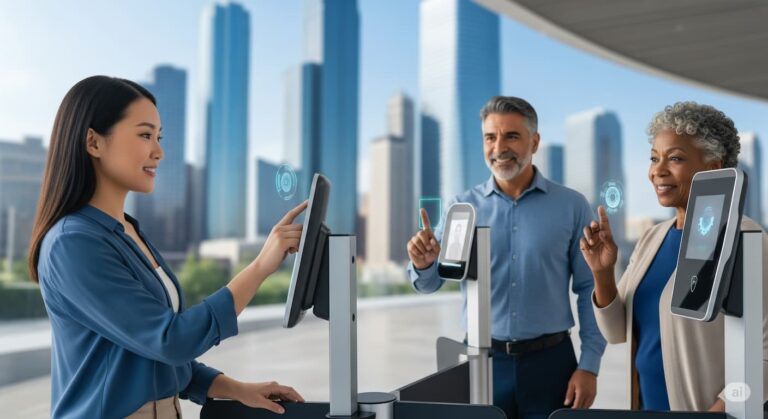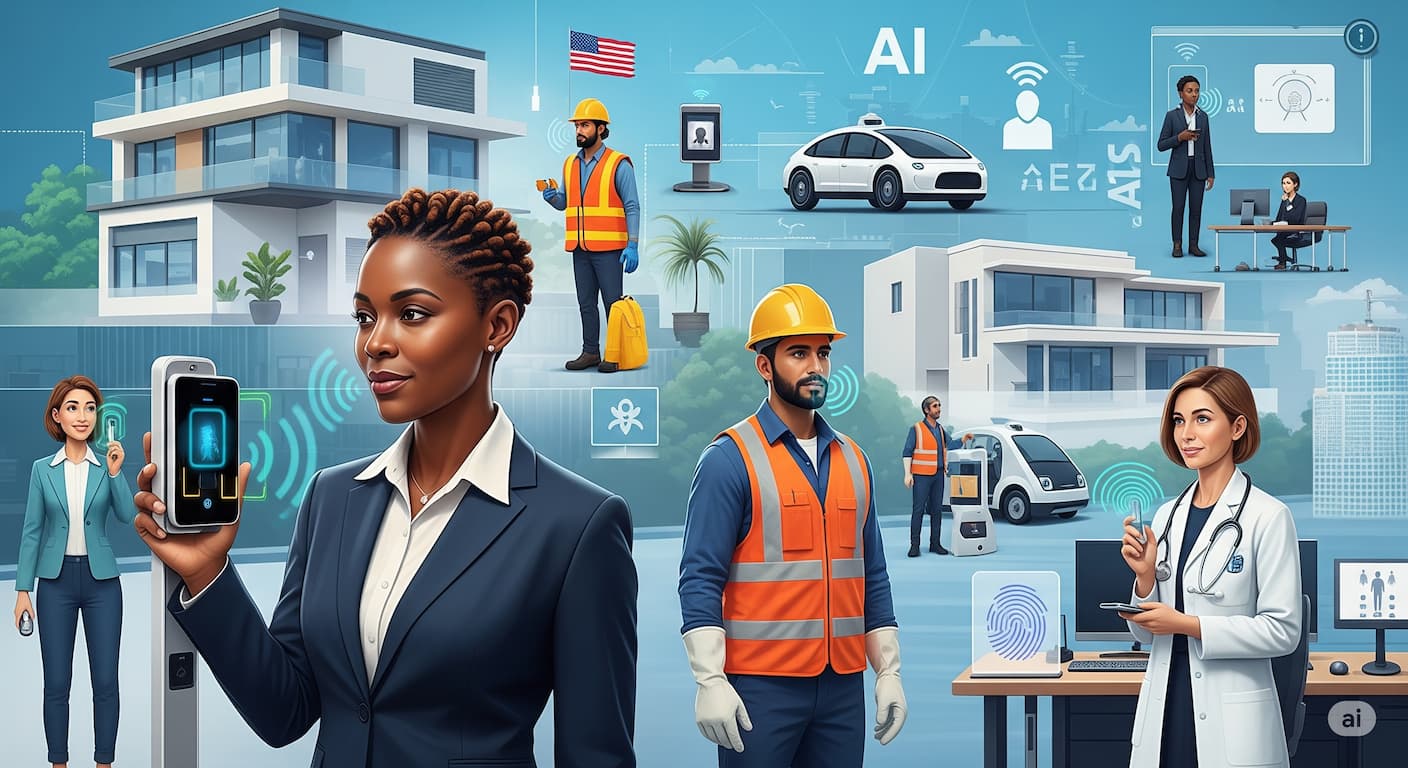Let’s begin with a simple situation. Imagine you’re unlocking your phone. You just look at the screen—no passwords, no PIN. The phone scans your face, confirms it’s really you, and lets you in. Simple, right? What you may not realize is that behind that little moment is a smart, fast technology called AI in biometric security. It’s quietly changing how Americans access banking apps, unlock smart homes, and even check-in at airports.
This blog dives into how AI in biometric security is shaping the future of identity protection in the USA — and why it matters to people like you and me.
What Is AI in Biometric Security?
To put it simply, AI in biometric security means using artificial intelligence (AI) to make security systems smarter when they check your identity using something unique about your body — like your face, voice, or fingerprints.
Biometrics already exists in things like:
- Unlocking your iPhone with Face ID
- Logging into mobile banking using fingerprints
- Airport security checks that scan your face
AI steps in to make these processes faster, more accurate, and harder to fool. It learns patterns in your voice, facial structure, or even how you walk. The more it learns, the better it gets at recognizing you.
Why the USA Is Leading the Way in Biometric Adoption
The United States is a hotspot for biometric innovation, and for good reason:
- It has tech giants like Apple, Google, and Microsoft investing heavily in AI.
- Government agencies (like the TSA and DHS) are rolling out biometric systems at borders and airports.
- Banks and fintech companies want better ways to stop fraud without annoying customers.
In 2023, the U.S. had over 60% of smartphones equipped with biometric capabilities, and more than 70% of Americans said they trust biometrics more than passwords (Statista).
How AI in Biometric Security Works Behind the Scenes
You may not see it, but here’s what happens behind that facial scan:
- Image or signal is captured (face, voice, fingerprint)
- AI algorithm processes the data
- It matches it with your saved profile
- If it’s a match—it grants access; if not, it blocks
AI improves this process by:
- Learning with experience (machine learning)
- Detecting fake attempts (like a printed photo or a deepfake video)
- Adapting to changes, like growing a beard or wearing glasses
In short: AI helps biometric systems behave more like a smart assistant than a dumb lock.
Top Trends in AI-Driven Biometric Technology
Let’s explore what’s trending right now:
1. Multi-Modal Biometrics
Combining more than one method—like face + voice—for better security.
2. Liveness Detection
AI can tell if it’s a real person in front of the scanner, not a photo or video. This is crucial for fighting fraud.
3. Behavioral Biometrics
Looks at how you type, swipe, or walk—unique habits that AI can learn and verify.
4. On-Device AI
Biometric data stays on your device (like iPhones), giving more privacy.
5. AI + Blockchain
Some startups are merging AI biometrics with blockchain to make digital identity more secure and private.
Facial Recognition: From Airports to Smartphones
In the USA, facial recognition is becoming mainstream — especially at:
- Airports like Atlanta, LAX, and JFK
- Government buildings
- Mobile devices (Face ID, Android facial unlock)
CBP (Customs and Border Protection) uses facial scans to match travelers to their passport photos. This speeds up immigration and enhances security.
But it’s not just for travel. Companies like Clear and Delta Airlines are offering facial ID to board planes, check luggage, and enter lounges—no need to show documents.
Voice Biometrics: Speaking Your Identity
“Your voice is your password.”
That’s now true for many American banks and call centers.
Voice biometrics analyzes:
- Pitch
- Tone
- Speaking speed
- Unique vocal patterns
For example, Chase Bank and Wells Fargo use voice recognition to verify customers over the phone—making identity theft harder and the experience smoother.
Plus, AI learns how your voice changes over time, including if you’re sick or using a different phone.
Touchless Fingerprint and Iris Scans: The New Normal?
Due to COVID-19, people wanted touchless options. AI helped bring that faster:
- Iris recognition (used at some airports and hospitals)
- Palm vein scans (used in some U.S. retail pilot programs)
- Contactless fingerprint scanners, now available in public spaces like banks
These technologies are not just cleaner—they’re smarter and faster with AI.
AI in Biometric Security for Banks and Finance
This is where AI in biometric security is making a real difference.
Here’s how:
- Faster onboarding: You can open a bank account by scanning your face and an ID. AI checks both instantly.
- Fraud detection: AI spots unusual behavior (like logging in from a new country) and may ask for a face or voice check.
- Customer service: Instead of security questions, AI verifies your voice and connects you quickly.
Banks using this tech include:
- Bank of America
- CitiBank
- Capital One
Many Americans appreciate the convenience—especially when they’re in a rush or abroad.
Public Safety and Surveillance: Where Is the Line?
While biometrics help with safety, there are concerns too.
Cities like New York and Chicago use facial recognition in public spaces. Police departments use it to identify suspects.
However, there’s debate about:
- Bias: Some AI systems are less accurate for certain skin tones
- Privacy: Do people know they’re being scanned?
- Oversight: Who is watching the watchers?
Some U.S. cities, like San Francisco, have banned certain facial recognition tools for public use. It’s a balance between safety and freedom.
The Privacy Debate: What Americans Need to Know
Biometrics feel personal—because they are. Once your face or fingerprint is compromised, you can’t “change” it like a password.
Here’s what to watch out for:
- Where your biometric data is stored
- Who can access it
- What happens if it’s stolen or misused
The U.S. lacks a national biometric privacy law (unlike the EU’s GDPR). However, states like Illinois (BIPA) and California (CCPA) have introduced their own rules.
As a user, always read privacy policies and use biometric features that store data on your device, not in the cloud.
What’s Next? The Future of Biometric Identity in the USA
Here’s what we might see soon:
- Biometric voting for local and national elections
- AI-powered digital IDs that replace driver’s licenses
- Biometrics for online shopping—say goodbye to passwords forever
Tech firms are working on emotion detection through facial scans, while others are exploring DNA-based biometrics.
Sounds futuristic? It’s already being tested in places like Silicon Valley.
Practical Takeaways for Everyday Users
Here’s what you can do now:
- Use multi-factor authentication—biometrics + password is safer than just one.
- Choose apps with on-device biometric storage.
- Understand privacy settings on your devices and apps.
- Ask questions when using facial recognition in public—know your rights.
- Update your phone’s software to keep biometric systems accurate and secure.
Final Thoughts: Are We Ready for an AI-Verified World?
AI in biometric security isn’t just a tech trend—it’s part of our daily lives now. From unlocking your phone to boarding a flight, AI is helping systems recognize us better, faster, and more safely.
But we also need to stay informed, ask questions, and demand fair use.
As Americans, we value both convenience and freedom. With smart regulations and public awareness, we can enjoy the benefits of biometric security—without giving up control over our identities.
Would you trust AI to recognize you better than your best friend?
Sources and References
- Statista – U.S. Biometrics Usage and Trust Levels (2023): https://www.statista.com
- CBP – Biometric Entry/Exit Fact Sheet (2023): https://www.cbp.gov
- Financial Times – AI in Banking (2023)
- Clear and Delta Facial Recognition News: https://www.clearme.com
- BIPA (Illinois Law): https://www.ilga.gov/legislation
- CCPA – California Privacy Act: https://oag.ca.gov/privacy/ccpa
- MIT Technology Review – AI Bias in Facial Recognition (2022)



